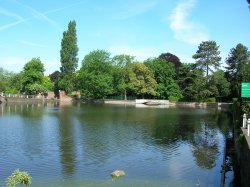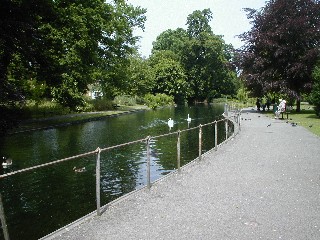

The cache is a small container and will only fit a very limited
number of small swaps.

Carshalton Ponds
The coordinates for the final cache must be obtained by going to
the coordinates listed below. There you will find some
information.
The coordinates for the final cache are:
N51 21.ABC
W00 09.DEF
Location 1
N51 21.960 W 00 09.862
The area was dedicated by the Bishop of Woolwich on 9th September
19D1.
Location 2
N51 21.913 W 00 09.897
Novelist and philosopher William Hale White first lived here in
1E64-F.
Location 3
N51 21.901 W 00 09.811
Sir John Fellowes dies in 1B24.
Location 4
N51 21.908 W 00 09.730
The London Twopenny Post was extended to Carshalton in
1A02
Location 5
N51 22.030 W 00 09.716
Tony Hughes died in 19C1.
Carshalton has an interesting history. Originally known for its
springs, which gave it its name Car-aul-ton. Aul means well and
ton, a farm. The area was made up of 5 separate estates, which may
have become the sites of large early modern houses and farms. It is
suspected that Stone Court (now home to Sutton Council), Carshalton
House (now St Philomena’s school), Carshalton Park House, Samuel
Long’s House and Westcroft (where there is now a leisure centre)may
have been the original 5 estates.
Current excavations in the car park of The Grove have discovered
foundations of a large 12th -13th century house which may have been
a predecessor to Stone Court.
At the time of the creation of the Domesday book, Carshalton had a
church, a water mill and was almost certainly several scattered
hamlets, rather than one village.
The later history indicates that Carshalton grew rapidly in the
12th and 13th century, with the then Lords of the Manor, the de
Colvilles, holding markets and fairs, which resulted in the
creation of The Square and the High Street.
The 17th century saw the development of several watermills along
the River Wandle, one of which can still be seen in The Grove
today. These were flour mills, fed by local farmers. Throughout the
17th and 18th century a whole series of industries developed along
the river, with numerous mills being put up to make full use of the
water power available. At one time, mills worked leather, copper,
gunpowder, snuff, paper and linseed oil.
Alongside the growth in industry, Carshalton saw a growth in houses
erected for wealthy landowners. The demand for land meant that even
the larger houses had small gardens, and competition to create the
best ‘look’ was fierce, using the best architects and designers of
the time. Thomas Scawen, constructed an elaborate garden in the
grounds of Stonecourt, now The Grove. In doing so, he canalised
some of the river and created the famous lower pond. The Portland
Stone bridge where the Wandle flows into the pond is believed to
have been designed by Scawen’s Italian architect, Leoni.

A view along the canalised River Wandle
By the mid 19th Century, Carshalton had grown to become the largest
village in the now London Borough of Sutton, with a population of
2,411. It’s residents lived in a stark mixture of rich houses at
one extreme, and squalid tenements at the other. Swan Yard in West
Street and Wandle Mount between The Grove and the High Street were
particularly notorious. The buildings in the village varied from
timber framed houses from the middle ages, to brick and wooden
buildings from the 17th, 18th and 19th centuries.
This multi-cache is accessible to people with disabilities and
families with pushchairs. The walk is a short one, which will
introduce you to some of the varied and interesting history of
Carshalton, especially Scawen’s pond, Stone Court and The
Grove.
The clues are all located within a small area, predominantly on
flat paths, and there are numerous facilities for families which
make it a real day (or at least a few hours) out. The walk does,
however, involve crossing a busy road, so take care, although the
traffic is often stationary, so it should not pose too much
trouble.
Carshalton Ponds are rich in birdlife, and there is always the
opportunity to feed the ducks (and a large number of very friendly
squirrels!) Nearby, there is a heritage centre which will tell you
some of the history of the area, but this does involve additional
cost.
Within Grove Park, you will find a network of flat, winding paths
next to the Wandle River. Children can enjoy a large adventure
playground, and crazy golf.
Refreshments can be found at the Park Café which also has toilet
facilities during opening hours. There are also 2 pubs – The
Greyhound and The Woodman, each with their own history, which you
will pass on your search for clues.
Carshalton Ponds and Grove Park are very popular, particularly on
nice afternoons, so a little ‘muggle-avoidance’ may need to be
employed when you search for the actual cache.

Stonecourt House in the 1920s.